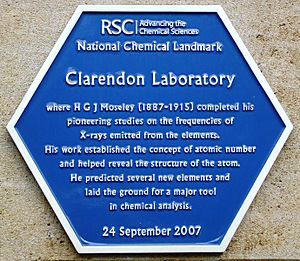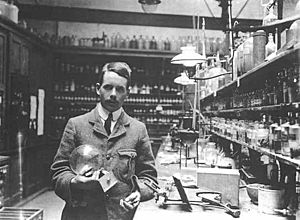Henry Moseley facts for kids
Quick facts for kids
Henry Moseley
|
|
|---|---|

Moseley in 1914
|
|
| Born |
Henry Gwyn Jeffreys Moseley
23 November 1887 |
| Died | 10 August 1915 (aged 27) |
| Cause of death | Killed in action |
| Nationality | English |
| Citizenship | British |
| Education | Summer Fields School Eton College |
| Alma mater | Trinity College, Oxford University of Manchester |
| Known for | Atomic number, Moseley's law |
| Awards | Matteucci Medal (1919) |
| Scientific career | |
| Fields | Physics, chemistry |
| Influences | Ernest Rutherford |
Henry Gwyn Jeffreys Moseley (born November 23, 1887 – died August 10, 1915) was an English physicist. He made a very important discovery about chemical elements. Moseley studied the X-rays that different elements give off. He found a special rule, now called Moseley's law. This law connects the X-ray's wavelength to an element's atomic number.
Before Moseley's work, the "atomic number" was just an element's spot on the periodic table. People didn't know it was linked to anything you could measure. Moseley's law showed that atomic numbers are real physical properties. This helped arrange the periodic table in a much more logical way.
When World War I started, Moseley stopped his research. He joined the British Army as a volunteer. He served as a communications officer in Gallipoli, Turkey. Sadly, he was killed there on August 10, 1915, at just 27 years old.
Contents
Henry Moseley's Early Life and School
Henry G. J. Moseley, known as Harry to his friends, was born in Weymouth, Dorset, England, in 1887. His father, Henry Nottidge Moseley, was a biologist and a professor at the University of Oxford. He passed away when Henry was very young. Henry's mother, Amabel Gwyn Jeffreys, was also from a family of scientists. Her father was a famous biologist.
Henry did very well in school. He attended Summer Fields School and later earned a special scholarship to Eton College. In 1906, he went to Trinity College, Oxford at the University of Oxford. There, he earned his first university degree.
His Amazing Scientific Discoveries
After finishing at Oxford in 1910, Moseley started working at the Victoria University of Manchester. He worked under the famous scientist Ernest Rutherford. At first, Moseley had to teach students. But after his first year, he became a full-time research assistant. This meant he could focus only on his experiments.
In 1913, Moseley began to study X-rays. He looked at the X-ray patterns given off by different chemical elements, especially metals. He noticed something amazing. There was a clear mathematical link between the wavelengths of these X-rays and the atomic number of the element. This important finding became known as Moseley's law.
Moseley's discovery proved that atomic numbers were not just random numbers. They were based on the physics of how elements behave. He suggested that each element in the periodic table has one more positive charge in its nucleus than the element before it. His work helped put the elements in a perfect order on the periodic table. This made the periodic table much more accurate and useful.
A Sad End and Lasting Impact
In early 1914, Moseley left his job in Manchester. He planned to go back to Oxford to continue his physics research. However, World War I began in August 1914. Moseley decided to join the British Army instead of taking the new job.
He became a technical officer in communications. He served during the Gallipoli Campaign in Turkey. On August 10, 1915, he was killed by a sniper. He was only 27 years old.

Many scientists believe that if Moseley had lived, he would have made many more important discoveries. Isaac Asimov, a famous writer, said that Moseley's death might have been "the most costly single death of the War to mankind generally." This shows how important his potential contributions were.
Memorials to Moseley were put up in Manchester and Eton. A special scholarship was created in his name by the The Royal Society. The second person to receive this scholarship was Patrick Blackett, who later became the president of the Royal Society.
Interesting Facts About Henry Moseley
- Moseley's mother was the British women's chess champion in 1913.
- Moseley's work showed that there were missing elements in the periodic table. These were at atomic numbers 43, 61, 72, and 75. Today, we know these are technetium, promethium, hafnium, and rhenium. These elements were unknown when Moseley was alive.
- His family and friends tried to convince him not to join the army. But Moseley felt it was his duty to serve his country.
- Some scientists think Moseley would have won the Nobel Prize if he hadn't died so young.
- The Institute of Physics has a special award named after him: the Henry Moseley Medal and Prize.
See also
 In Spanish: Henry Moseley para niños
In Spanish: Henry Moseley para niños


